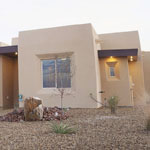As an architect, Javier Cabrera had issues convincing contractors to use green materials. So he partnered with his cousin, Emmanuel Dominguez, who has a degree in civil engineering, to launch NetSolar. The company does construction but also manufactures structural insulated panels and installs photovoltaic systems. Starting in 2010 in their hometown of Las Cruces, New Mexico, Cabrera and Dominguez built four custom homes as NetSolar before breaking ground on the Metro Verde Development, where the company decided to go for the maximum of LEED Platinum certification. NetSolar recently completed the first two homes, each roughly 2,500 square feet, and have four homes currently in construction. We spoke with Cabrera about the challenges of achieving LEED Platinum in a residential environment.
gb&d: Why did you decide to go for LEED Platinum for the Metro Verde homes?
Javier Cabrera: We are trying to set the LEED standard on homebuilding here in southern New Mexico. Not only is it the right thing to do and better for the consumer, but it is healthier and less expensive than a traditional home to operate. Also, the Metro Verde subdivision was already green certified for its drainage and roadways. It was the first green-certified subdivision in the state.
gb&d: What challenges did you overcome to build to LEED Platinum standards?
Cabrera: One of the main challenges was educating the subcontractors, suppliers, and all of our employees because they were not used to customers asking for recycled material and energy-efficient appliances and fixtures. With suppliers, we needed them to get FSC-certified lumber and GreenGuard-certified tile. Realtors also had to be educated on energy-efficient features so they could sell the homes. Another challenge in the region was finding a green-certified appraiser.
gb&d: What were some of the sustainability lessons you learned in the process of building the first two homes?
Cabrera: We learned that building green is not more expensive than building a traditional home. It just takes a little extra time to plan ahead. It helps somewhat that we’re doing the manufacturing of the insulation. We learned the process for certifying LEED, and we learned better techniques to improve the performance of the house, so on these next four houses, we will reduce errors and increase performance time.
gb&d: What has this success done for your firm? Is your sustainability practice driving your business growth?
Cabrera: Yes, lots of people are interested. An article was written about the two completed Metro Verde homes in the local newspapers, and people who are interested in buying green homes are reaching out to us. Also, other homebuilders are approaching us for either products or advice, so that’s a good sign of improvement.
gb&d: How will you stay above the sustainability curve going forward and continue to innovate?
Cabrera: We’re always doing research and taking lessons online from places like Energy Star and the Environmental Protection Agency. We also are members of the USGBC and the AIA, so we regularly get information from them on new technologies. We talk with customers about what they are looking for in a home and what they wish they could do differently, and we spend time at the open houses to get people’s feedback on what they like, what they don’t like, and how we can improve from there.

